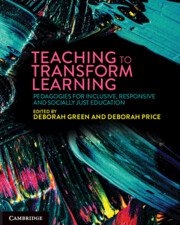Book contents
- Teaching to Transform Learning
- Acknowledgement of Country
- Teaching to Transform Learning
- Copyright page
- Contents
- Contributors
- Acknowledgements
- Introduction Understanding the learner to inform educators’ implementation of pedagogical approaches to transform learning
- Part 1 Pedagogies for all
- 1 Aboriginal pedagogies: exploring Indigenous ways of knowing, being and doing
- 2 Making lifeworld connections through critical pedagogies
- 3 Culturally responsive pedagogies: learners as assets
- 4 Traversing identities: navigating the self, school and system for culturally responsive pedagogies
- 5 Culturally and religiously responsive pedagogy: a case study of enabling pedagogy for superdiverse Australian classrooms
- 6 Enabling pedagogy and critical teaching approaches in diverse learning contexts
- 7 Pedagogy of hospitality
- Part 2 Engaging pedagogies: making the curriculum come alive for all learners
- Part 3 Empowering pedagogies: 21st-century skill development and 22nd-century futures thinking
- Index
- References
1 - Aboriginal pedagogies: exploring Indigenous ways of knowing, being and doing
from Part 1 - Pedagogies for all
Published online by Cambridge University Press: 25 October 2024
- Teaching to Transform Learning
- Acknowledgement of Country
- Teaching to Transform Learning
- Copyright page
- Contents
- Contributors
- Acknowledgements
- Introduction Understanding the learner to inform educators’ implementation of pedagogical approaches to transform learning
- Part 1 Pedagogies for all
- 1 Aboriginal pedagogies: exploring Indigenous ways of knowing, being and doing
- 2 Making lifeworld connections through critical pedagogies
- 3 Culturally responsive pedagogies: learners as assets
- 4 Traversing identities: navigating the self, school and system for culturally responsive pedagogies
- 5 Culturally and religiously responsive pedagogy: a case study of enabling pedagogy for superdiverse Australian classrooms
- 6 Enabling pedagogy and critical teaching approaches in diverse learning contexts
- 7 Pedagogy of hospitality
- Part 2 Engaging pedagogies: making the curriculum come alive for all learners
- Part 3 Empowering pedagogies: 21st-century skill development and 22nd-century futures thinking
- Index
- References
Summary
For thousands of years Aboriginal and Torres Strait Islander people nurtured their young, allowing natural skills to develop. Education using the powers of observation and listening was the most important process used with information being delivered to the child when they were ready to receive it. Most times this information was delivered by several members of the community. Prominent Australian Aboriginal scholar Kaye Price (2012) affirms that ‘right from the beginning there was a specialised education and for each child there was a teacher, a mentor and a peer with whom to learn … who ensured that history and the essentials of life were taught’ (p. 4). Aboriginal society was based on an egalitarian system that was holistic and emphasised belonging, spirituality, and relatedness. Learning was viewed as a natural holistic process where education was centred on the land and children learned alongside adults (Martin, 2005). The traditional epistemological system that maintained Aboriginal Nations in Australia for millennia was disrupted upon colonisation in 1788 resulting in discrimination towards Aboriginal culture and traditions (Morgan, 2019).
Keywords
- Type
- Chapter
- Information
- Teaching to Transform LearningPedagogies for Inclusive, Responsive and Socially Just Education, pp. 12 - 29Publisher: Cambridge University PressPrint publication year: 2024

